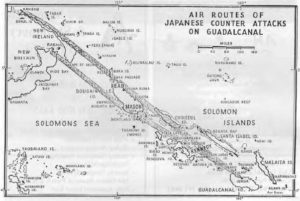- Author
- Gregory, Mackenzie J.
- Subjects
- Naval Intelligence, History - WW2
- Tags
-
- RAN Ships
- None noted.
- Publication
- April 1993 edition of the Naval Historical Review (all rights reserved)
Let me quote Eric Feldt who sets the scene so very lucidly in his book “The Coast Watchers”.
“Members of our forces have now learnt from hard experience of the mountains, the jungle, the rain and the mud, with the contrast of burning sun on open Kunai Plains of flat soggy swamps and water logged beaches, of fever and dysentery and tropical ulcers and scrub typhus, and the summation of all of these which saps the energy and endurance and is a constant brake on human endeavour.
Now any staff officer can foretell the conditions troops will encounter and make arrangements to meet them and minimize the worst effects.
But not many men knew these things when Japan made war on us in December 1941, when that knowledge was essential to a campaign in the North East area.
Natives had the knowledge, but would not convey it to others, or use the knowledge themselves in warfare, except in a very limited field.
There were Europeans who had that lore, gained from experience, and it was from these that the Coast Watchers were drawn. The conditions of the area set the limits and provided the scope of the Coast Watchers’ work. Terrain, climate and local resources were all of consequence, but the most important was the relationship of the native to the European“. Coast Watching Chain Completed

By early August 1942, Coast Watchers were installed at Sergi, on Southern Isabel, on Guadalcanal, Malaita, and San Cristobal; thus covering the Japanese who were working to fortify Tulagi, and build an airfield on Guadalcanal.
It was Major Martin Clemens, a Coast Watcher who warned Feldt of the impending problems posed by the completion of the airfield at Guadalcanal.
Americans Warned
Clemens’s warning was quickly passed on to Admiral King, Naval Chief of Staff in the United States. King wanted to make sure that the proposed “Operation Watchtower” designed to retake Tulagi, and occupy Guadalcanal with U.S. Marines was brought to fruition prior to the Japanese airfield being built on Guadalcanal becoming operational.
Admiral King was determined that his invasion force would not be at the mercy of Japanese aircraft attacks mounted from a close by, land based airfield.
The Marines Arrive
In August 1942, I was serving as a Sub Lieutenant R.A.N. and a Bridge Watchkeeper in H.M.A.S. CANBERRA.
We were part of the Naval Support Group covering the Marine invasion force which commenced its operation on 7th August, 1942.
It was in this operational zone during the next few days, that I had firsthand experience of both the efficiency and tactical value of the Coast Watching service.
The Japanese Response
In CANBERRA we were warned over the ship’s broadcasting system: “all hands will go to dinner at 1100 as we expect a Japanese air attack“.
Paul Mason, the Australian Coast Watcher hidden on Bougainville, South West of Kieta sent this invaluable information. As he so rightly forecast, the air raid arrived to attack the fleet and troop laden transports. Sixteen Japanese aircraft were shot down for the loss of twelve carrier aircraft.
The U.S. destroyer MUGFORD was hit during the raid and twenty of her crew killed.
On 8th August Jack Read, another Australian Coast Watcher situated on the northern end of Bougainville, gave us a warning of forty Japanese bombers flying South East. About midday, the Fleet was attacked by this force of torpedo bombers, who fiercely pressed home their attack. Guns of the Fleet accounted for seventeen of these “Betty” bombers, and at one stage I could count six blazing aircraft as they crashed on the water.
The U.S. destroyer “JARVIS” was torpedoed, and the transport GEORGE F. ELIOT had a blazing aircraft crash on board; of necessity, she was abandoned that night, and grounded south of Florida Island.
Coast Watching 1943-44
Throughout the year of 1943, and up to October 1944, the Coast Watching Service played a very valuable part in the Pacific war. To quote Feldt “…but Coast Watching, that is, the obtaining of intelligence from enemy occupied areas, was finished. The Coast Watchers had done their job, and, for their numbers, had made a contribution out of all proportion“.




